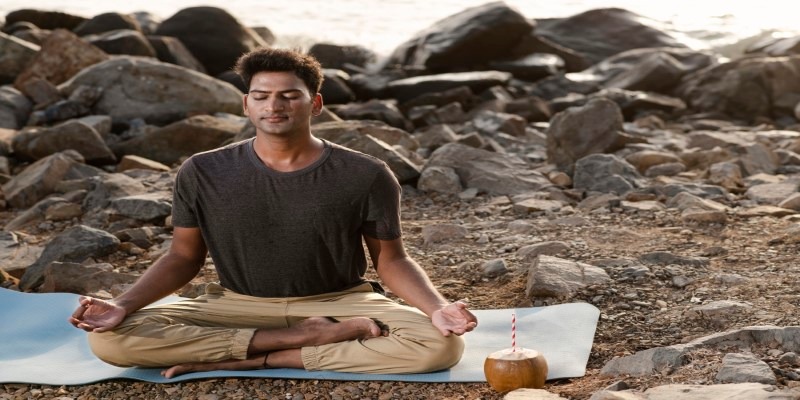Mastering the Wall Sit: Methods, Advantages, and Variations
Nov 22, 2023 By Madison Evans
Wall sits are a simple yet underrated exercise that may boost fitness. Engaging different muscle groups in your workout builds strength, endurance, and stability. Understanding wall sits allows you to maximize their benefits and improve your exercise.
A wall sit includes sitting against a wall with your knees bent 90 degrees. It targets lower body muscles, including quadriceps, hamstrings, and glutes. As we study wall sit methods, advantages, and variants, we realize that this essential exercise can be effective properly.

Techniques for Proper Execution:
Wall sit skills must be mastered to maximize advantages and avoid injury. Start with proper posture: put your back against the wall, maintain your feet shoulder-width apart, and lower your body until your knees make a straight angle. Proper form prevents joint stress and maximizes muscle activation.
Additionally, knowing the correct length and frequency is crucial. Beginners may start with shorter periods and progress as they strengthen. Being consistent is essential, but overtraining may cause weariness and injury. During a wall sit, mindful breathing oxygenates muscles, boosts endurance, and maximizes workout efficacy.
Benefits of Wall Sits:
Wall sits provide several advantages beyond lower body strength. This isometric exercise increases muscular endurance and is an excellent supplement to any workout. Quadriceps and hamstring strength improves knee stability and joint health, making wall sits useful for knee prevention and rehabilitation.
Wall sits also improve stability by using core muscles. This improves posture and physical performance. Wall sits, a weight-bearing activity can prevent osteoporosis and preserve skeletal health as people age. Finally, wall sits fit within a well-rounded weight-loss workout program since they burn calories.
Variety to Spice Up Your Workout:
Variating your wall sit practice may keep your exercise interesting. A dumbbell or resistance band on your thighs enhances the workout and challenges your muscles. Single-leg wall sits stimulate particular muscles and improve balance, demanding more stability.
Movement adds agility to wall sits for a more dynamic exercise. Examples include pulsing, lateral leg lifts, and wall sits with bicep curls. Advanced varieties like a one-legged wall sit, or wall sits on unstable surfaces let athletes test their boundaries.
Common Mistakes to Avoid:
Wall sits are a flexible and safe exercise, but frequent missteps may reduce efficacy. Avoid curving your back and extending your knees beyond your toes to maintain good form. These mistakes may strain your lower back and knees, causing pain or damage.
Neglecting correct breathing during a wall sit reduces muscle oxygen flow, decreasing endurance and performance. To give your muscles enough oxygen to work, breathe properly, and don't hold your breath. Overexertion and lesser wall sit advantages might result from disregarding fitness levels and trying advanced variants without enough strength.

Tips for Beginners: Building Strength Safely:
Beginners should gradually and mindfully introduce wall sits to increase strength and avoid burnout. Start wall sit practice with 20–30 second intervals. This first phase reduces tiredness and prepares your muscles for this unique workout.
Increase wall sit time as you become used to them. This progressive rise lets your muscles adapt to the activity, building strength sustainably. Being patient during this period is essential since the objective is to build a firm foundation for future advancement.
Consider using assistance to ease into the exercise and maintain form. For individuals building core strength, a stability ball between your back and the wall may help. This added support keeps your attention on good technique and eliminates compensatory movements that might reduce wall sit effectiveness.
You must listen to your body during this process. Take a stop whenever you feel pain beyond muscular weariness or if your form falters. Consistency and intentional progression avoid injuries and help muscles adapt and develop. This patience creates a lasting and efficient fitness path, making wall sits a gratifying part of your routine.
Integrating Wall Sits into Full-Body Workouts:
Wall sits judiciously placed in full-body workouts may boost their effectiveness. You target numerous muscle groups with a complete strategy by considering synergy with other workouts. Pairing wall sits with bicep curls or shoulder presses works well. This maximizes gym time and balances upper- and lower-body strength.
Adding wall seats to circuits boosts their efficiency. Continuous activity from muscle group circuits promotes cardiovascular health and challenges diverse body parts. A dynamic circuit of wall sits, lunges, and planks may improve fitness. This comprehensive approach makes workouts effective and promotes a well-rounded body.
In addition to building muscle, full-body wall sits increase stability and coordination. The core is challenged by upper and lower body muscles, improving balance and proprioception. This integrated method boosts physical performance and makes your workouts more fun.
In conclusion, carefully adding wall sits to full-body exercises diversifies fitness. Synergizing with other exercises and building well-rounded circuits boosts muscle group impact and overall strength, stability, and coordination. This comprehensive approach deepens your training and makes it more fun and effective.
Progressive Wall Sit Challenges: Overcoming Plateaus
Breaking plateaus is essential for fitness progression as you progress. This section covers increasing tasks to keep your wall sit routine interesting and push your muscles.
Slowly increasing wall sit time is a critical tactic. As your strength develops, sitting time naturally increases. Add 10 seconds to your typical time, then work up to longer intervals. This slow technique minimizes overexertion and lets muscles adjust.
Intensity differences make wall sits more difficult. Holding weights or wearing a weighted vest may boost resistance. The additional weight intensifies muscle contractions, building strength. Advanced versions like a one-legged wall sit, or dynamic motions add complexity and test your muscles.
Advanced variants must be explored to avoid stagnation and maintain physical growth. This may entail trying unstable surfaces, balancing components, or wall sits with other challenging exercises. These methods keep your muscles from becoming bored and provide a varied exercise.
In conclusion, incremental challenges are needed to overcome wall sit plateaus. These methods help you push your muscles, avoid stagnation, and gain steady fitness by increasing time, intensity, and variety. Let these incremental challenges push you to new strength and endurance levels as your fitness journey evolves.
Conclusion:
In conclusion, adding wall sits to your workout regimen requires learning the methods, comprehending the advantages, experimenting, and avoiding frequent mistakes. Multiple fitness levels benefit from this diverse activity. Wall sits are versatile enough for beginners to gain essential strength or seasoned fitness enthusiasts to vary their exercises.
Wall sits are most effective when consistent and focused. Stay dedicated to moderate improvement, excellent technique, and body awareness as you include this exercise in your program. Unlocking wall sits' full advantages help you reach your fitness goals: strength, stability, or general fitness. Accept the challenge, remain committed, and use wall sits' adaptability to reach your fitness objectives.

How to Get Rid of Hives: 9 Natural Remedies You Must Try

How Drinking a Gallon of Water Every Day Transformed My Skin

How to Effectively Practice Meditation: 9 Proven Approaches

Sugar Smart: 8 Strategies Dietitians Use to Moderate Daily Sugar Intake

Dark Spots on Face: Unpacking Potential Causes and Treatments

Retinol: The Truth Behind 5 Common Myths

Best Kidney Disease Treatments


